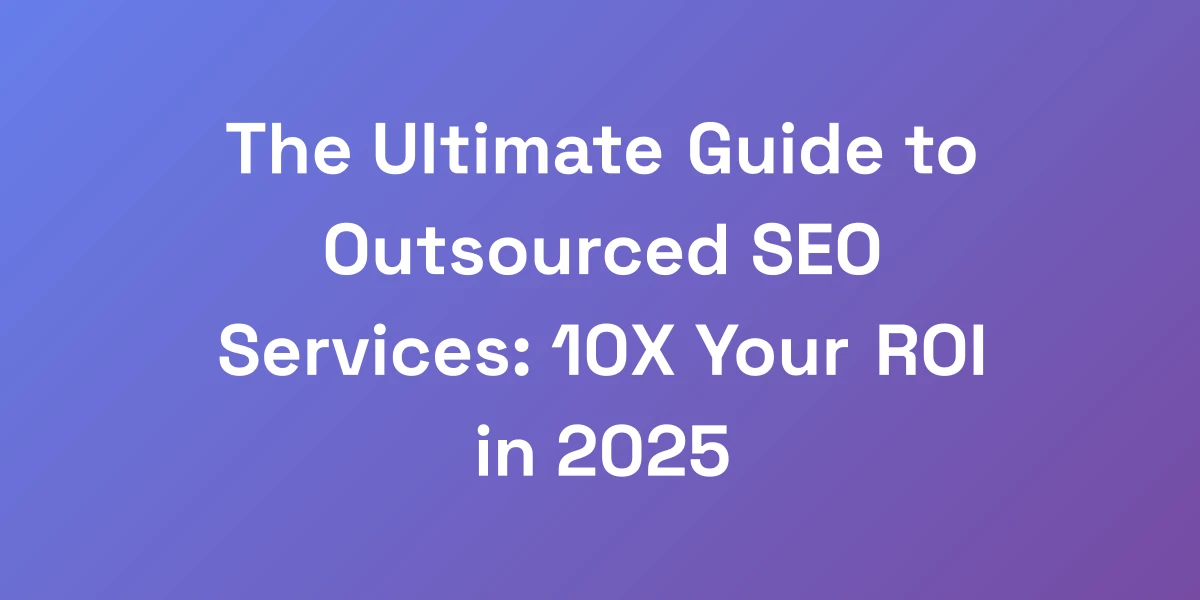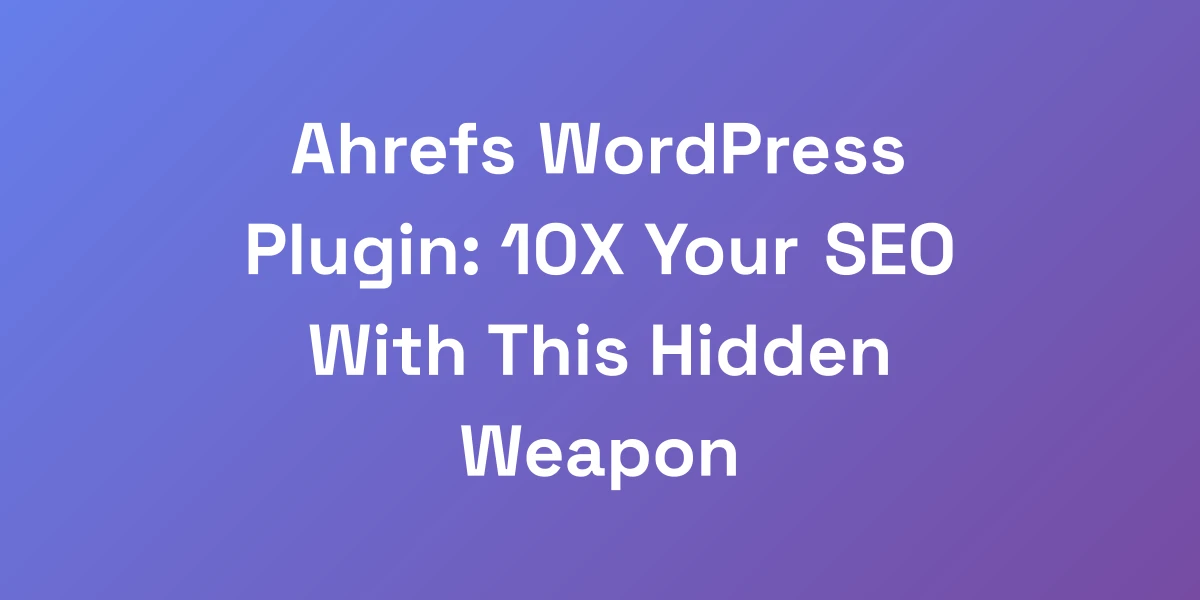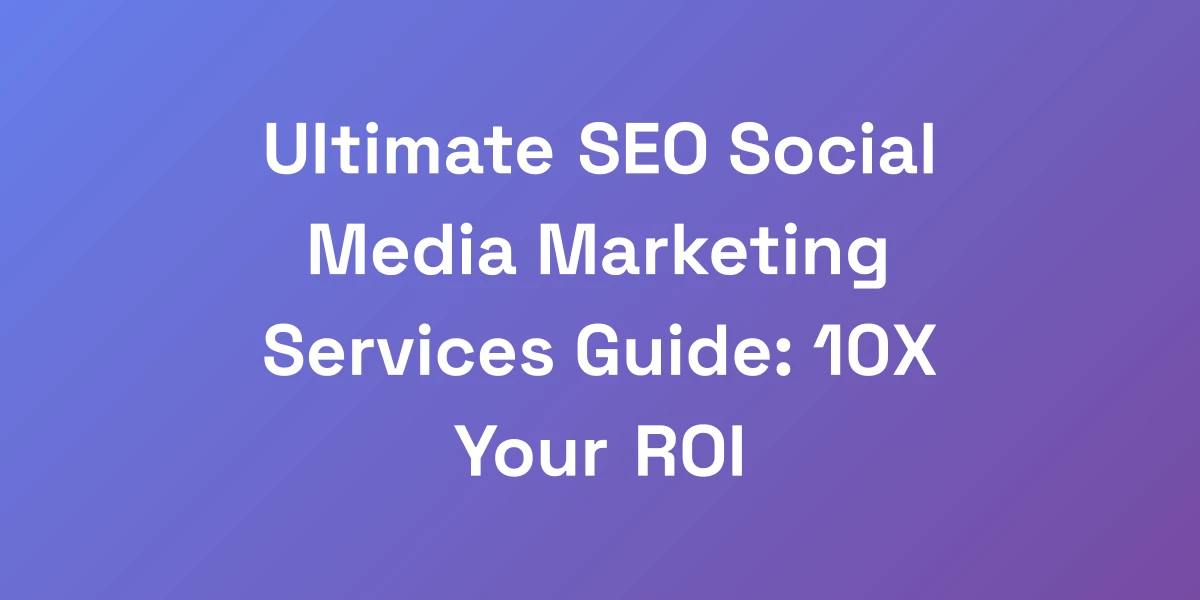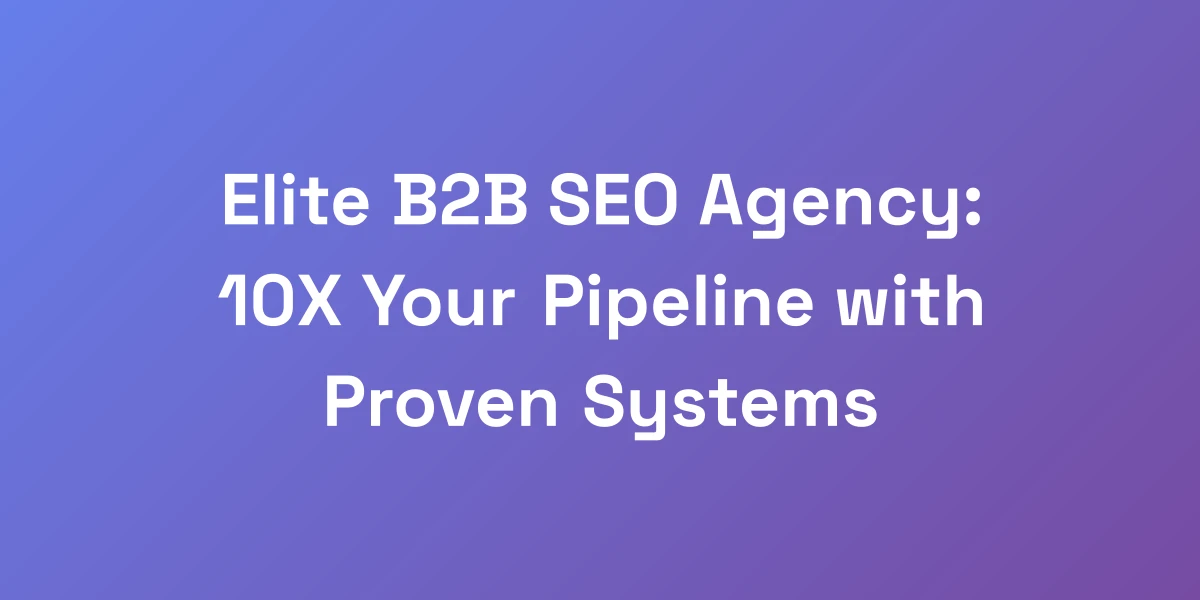
SEO PPC Services: Double Your ROI With This Proven Framework
Mar 30, 2025 | By [email protected]
Picture this: your business is stuck in a rut, pouring resources into SEO or PPC services, but not seeing the explosive growth you’re aiming for. Frustrating, right? We’ve been there, and we know exactly how it feels to watch potential profits slip through the cracks.
Here’s the raw truth: relying solely on SEO or PPC is akin to running a marathon with only one leg. It just doesn’t work. The real magic happens when you blend these two powerhouse strategies into a seamless SEO PPC framework that accelerates your ROI beyond what you thought possible.
In this article, we’re diving deep into a proven framework that not only combines SEO and PPC but also maximizes their collective potential. We’ll break down the strategies, share real-life success stories, and equip you with actionable tips to transform your marketing efforts. Ready to double your ROI? Let’s get started.
The $100M Secret: Why Top Brands Combine SEO & PPC Services
Let us hit you with some truth: if you’re running SEO or PPC in isolation, you’re leaving millions on the table. We’ve helped businesses scale from 6 to 8 figures by leveraging both channels, and here’s the kicker – it’s not about choosing one over the other. It’s about creating a symbiotic relationship that exponentially increases your return.
When you combine SEO and PPC services strategically, you’re not just adding results – you’re multiplying them. Let us show you exactly how the big players are doing this.
The Synergy Effect: How SEO & PPC Amplify Each Other
Imagine SEO and PPC as two sides of the same coin, each enhancing the other’s strengths. SEO builds your organic presence, establishing trust and authority over time. PPC, on the other hand, delivers immediate visibility and targets high-intent keywords that drive quick conversions.
But what’s the real advantage? It’s how these channels inform and optimize each other. For instance, data from PPC campaigns can reveal high-converting keywords that you can then focus on optimizing organically through SEO. Similarly, successful SEO strategies can lower your PPC costs by improving Quality Scores, ensuring your ads are more cost-effective.
Here’s how to harness this synergy:
- Keyword Data Sharing: Use PPC data to identify high-performing keywords and incorporate them into your SEO strategy.
- Enhanced Ad Targeting: Leverage SEO insights to create more targeted and relevant PPC ads.
- Unified Messaging: Ensure consistency in your messaging across both channels to build brand authority and trust.
Case Study: How We Doubled Client ROI in 90 Days
Let’s break down a real-world example. We worked with a mid-sized e-commerce company struggling to maximize their online presence. They had solid SEO and PPC campaigns, but neither was delivering the explosive growth they desired.
Our approach was simple yet effective:
- Integrated Keyword Strategy: We analyzed their PPC data to identify high-converting keywords and used these insights to enhance their SEO content.
- Landing Page Optimization: By aligning landing pages with both SEO and PPC goals, we improved user experience and boosted conversion rates.
- Holistic Performance Tracking: We implemented a unified tracking system to monitor the performance of SEO and PPC efforts in tandem.
The result? Within 90 days, their combined efforts led to a 200% increase in ROI, skyrocketing their revenue from $100,000 to $300,000. This isn’t an isolated success – it’s a blueprint anyone can follow.
The Cost-Benefit Analysis of Combined Services
Let’s talk numbers. Separately, SEO and PPC each require significant investment, and their returns can be limited. SEO typically shows results over 6-12 months, while PPC offers immediate but sometimes fleeting returns. Combining them optimizes budget allocation and [maximizes both short-term gains and long-term growth](https://lotiva.com/seo-vs-ppc-which-is-best-for-your-budget/).
Here’s a quick breakdown:
- SEO Investment: $1,500 – $5,000 per month for comprehensive services.
- PPC Investment: $2,500 – $50,000 per month, depending on campaign scale.
- Combined ROI: Businesses using both see up to 27% more profit compared to using a single strategy. Learn more about [PPC vs SEO ROI](https://adstage.io/ppc-vs-seo-which-has-better-roi/).
By interlinking these strategies, you not only cover more ground but also create a feedback loop that continuously enhances performance and ROI.
Common Myths About SEO-PPC Integration
There are several misconceptions that hold businesses back from integrating SEO and PPC effectively:
- Myth 1: SEO and PPC Don’t Complement Each Other – In reality, they enhance each other’s strengths and provide a balanced approach to capturing market share.
- Myth 2: Combined Costs Are Too High – When budgeted correctly, the synergistic benefits far outweigh the combined costs.
- Myth 3: It’s Too Complex to Integrate – With the right framework and tools, integrating SEO and PPC can be streamlined and manageable.
Don’t let these myths stunt your growth. Embrace the power of a unified strategy.
Quick Win Strategy for Immediate Results
Need to see quick improvements? Here’s a strategy that delivers fast:
- Keyword Overlap Analysis: Identify keywords that perform well in PPC and optimize them for SEO to boost organic rankings.
- Ad Copy Consistency: Ensure your PPC ad copy aligns with your SEO content to improve quality scores and ad relevance.
- Unified Analytics: Use tools like Google Analytics to track the performance of both channels in a single dashboard.
Implement these steps, and watch your visibility and conversions soar within weeks.
Engineering Your SEO-PPC Machine for Maximum Conversions
Here’s what nobody tells you about SEO PPC services: The magic isn’t in running both – it’s in how you engineer them to work together. We’re talking about creating a conversion machine that captures traffic at every stage of awareness. Your SEO builds trust and authority, while your PPC swoops in for the kill on high-intent keywords.
But here’s the real secret: Use your PPC data to inform your SEO strategy, and vice versa. Let us break down the exact framework we use.
The Perfect Keywords Split Strategy
Not all keywords are created equal. Some are best suited for PPC, while others thrive in organic search. Here’s how to split them:
- Brand vs. Non-Brand Keywords: Use SEO to dominate brand-specific searches and PPC for competitive non-brand terms.
- High-Intent vs. Informational: Target high-intent keywords with PPC for immediate conversions and use SEO for informational queries to nurture leads.
- Top vs. Long-Tail Keywords: Utilize PPC for top-of-funnel visibility with broad keywords and SEO for long-tail keywords that drive niche traffic.
This strategic division ensures you’re maximizing reach and capturing different segments of your audience effectively.
Conversion Rate Optimization Tactics
Optimizing conversion rates is crucial for both SEO and PPC. Here are actionable tactics:
- A/B Testing: Continuously test different versions of your landing pages to identify what converts best.
- Clear CTAs: Use strong, clear calls-to-action that guide users towards the desired action.
- Mobile Optimization: Ensure your landing pages are mobile-friendly to cater to the increasing number of mobile users.
Implement these tactics, and you’ll see a significant boost in your conversion rates, driving more ROI from both channels.
Cross-Channel Retargeting Framework
Retargeting is a game-changer. Here’s how to implement a cross-channel retargeting framework:
- PPC Retargeting: Re-engage visitors who clicked on your PPC ads but didn’t convert.
- SEO Retargeting: Target users who found you via organic search but didn’t take action.
- Unified Messaging: Ensure your retargeting ads are consistent across both channels to reinforce your message and drive conversions.
By retargeting across both SEO and PPC, you ensure that no potential customer slips away, maximizing your conversion opportunities.
Budget Allocation Formula
Proper budget allocation is key to maximizing ROI. Here’s our formula:
- Initial Split: Allocate 50% to SEO and 50% to PPC to establish a balanced presence.
- Performance-Based Adjustment: Continuously monitor the performance and adjust the budget based on which channel is delivering higher ROI.
- Seasonal Adjustments: Allocate more budget to PPC during peak seasons for immediate visibility and scale back during off-peak times to focus on SEO growth.
This dynamic approach ensures you’re always investing where it matters most, optimizing your budget for maximum returns.
Performance Tracking Metrics That Matter
Tracking the right metrics is essential for evaluating the success of your combined SEO-PPC efforts. Focus on:
- Click-Through Rate (CTR): Measures the effectiveness of your ads and organic listings in attracting clicks.
- Conversion Rate: Indicates how well your landing pages convert visitors into customers.
- Cost Per Acquisition (CPA): Helps you understand the cost-effectiveness of your campaigns.
- Return on Ad Spend (ROAS): Measures the revenue generated for every dollar spent on PPC.
- Organic Traffic Growth: Tracks the increase in visitors from organic search, reflecting the effectiveness of your SEO efforts.
By monitoring these metrics, including Google Ads benchmarks from 2022 to 2024, you can make data-driven decisions using automated SEO tools to continuously refine and enhance your strategy.
Advanced SEO-PPC Tactics That 10X Your Results
Stop following outdated playbooks. The game has changed, and we’re about to show you the advanced tactics that are working right now. We’re talking about leveraging AI for bid management, using RLSA to dominate your competition, and implementing dynamic search strategies that adapt in real-time.
These aren’t theory – these are the exact battle-tested methods we use to generate millions in revenue for our clients. Let us dive into the advanced stuff that nobody else is talking about.
AI-Powered Bid Management Systems
AI is revolutionizing bid management. Here’s how to implement AI-powered systems:
- Automated Bid Strategies: Use tools like Google Ads Smart Bidding to automatically adjust bids based on conversion likelihood or value.
- Predictive Analytics: Leverage AI to predict which bids will drive the highest ROI and adjust accordingly.
- Circuit Breakers: Set up AI-driven alerts to notify you of significant changes in campaign performance, allowing for swift adjustments.
By incorporating AI into your bid management, you ensure that your campaigns are always optimized for the best possible results. Explore more on 7 PPC AI tools that can skyrocket your ad performance.
RLSA Implementation Strategies
Remarketing Lists for Search Ads (RLSA) are a powerful tool. Here’s how to use them effectively:
- Segment Your Audience: Create specific lists based on user behavior, such as past visitors or those who abandoned carts.
- Tailored Ad Copy: Customize your ad messages to resonate with different segments, increasing relevance and conversions.
- Bid Adjustments: Increase bids for high-intent segments to ensure your ads appear prominently when they search again.
Implementing RLSA allows you to re-engage users who already showed interest, significantly boosting your chances of conversion.
Dynamic Search Term Integration
Dynamic search strategies keep your campaigns flexible and responsive. Here’s how:
- Real-Time Keyword Analysis: Continuously analyze search terms to identify emerging trends and adjust your strategy accordingly.
- Adaptive Ad Copy: Use dynamic keyword insertion to create ad copy that reflects the latest search trends.
- Content Refresh: Regularly update your SEO content to align with the changing search landscape, ensuring continued relevance and authority.
This dynamic approach ensures your campaigns are always aligned with current search behaviors, maximizing your reach and effectiveness.
Competition Analysis Framework
Staying ahead of the competition requires a robust analysis framework:
- Competitive Keyword Research: Identify the keywords your competitors are targeting and find gaps or opportunities to outperform them.
- Ad Copy Benchmarking: Analyze competitor ad copy to identify what’s working and how you can differentiate your messaging.
- Backlink Audits: Evaluate your competitors’ backlink profiles to discover new opportunities for your own SEO efforts. Check out Google ranking factors for more insights.
By systematically analyzing your competition, you can uncover strategies that give you a competitive edge in both SEO and PPC.
Advanced Analytics Setup
Data is the backbone of effective marketing. Here’s how to set up advanced analytics:
- Integrated Dashboard: Use platforms like Google Analytics and Data Studio to create a unified dashboard that tracks both SEO and PPC performance.
- Attribution Modeling: Implement cross-channel attribution models to understand how each touchpoint contributes to conversions.
- Custom Reporting: Develop custom reports that highlight key metrics and trends, providing actionable insights for continuous improvement. Consider using [bid management tools](https://www.lunio.ai/blog/bid-management-tools-ppc-comparison) for comprehensive analysis.
Advanced analytics empower you to make informed decisions using automated SEO tools, ensuring your campaigns are always optimized for maximum ROI.
Scaling Your SEO-PPC Campaign: From 6 to 7 Figures
Listen up, because this is where most businesses drop the ball. Scaling isn’t about spending more money – it’s about strategic expansion based on data. We’re going to show you exactly how to take your combined SEO-PPC campaign from generating $10,000 per month to $100,000+.
The key is in the systematic approach to scaling, testing new channels, and optimizing based on real performance metrics. Here’s the framework we use with our 7-figure clients.
Systematic Scaling Framework
Scaling requires a structured approach. Here’s our framework:
- Data-Driven Decisions: Use performance data to identify which strategies are working and should be scaled.
- Incremental Budget Increases: Gradually increase budgets to test the impact without risking overall performance.
- Performance Segmentation: Break down campaigns into segments based on performance to identify and focus on high-performing areas.
This framework ensures that scaling efforts are sustainable and effective, preventing common pitfalls associated with rapid growth.
New Channel Integration Strategy
Expanding into new channels can exponentially increase your reach and revenue. Here’s how to integrate new channels:
- Identify Opportunities: Research and identify new platforms where your target audience is active.
- Test and Learn: Launch pilot campaigns on new channels to gauge effectiveness before full-scale integration.
- Unified Messaging: Maintain consistency in your messaging and branding across all channels to reinforce your brand identity.
By carefully integrating new channels, you can tap into additional revenue streams without diluting your core marketing efforts.
Risk Management Protocol
Scaling comes with its own set of risks. Here’s how to manage them:
- Performance Monitoring: Continuously monitor campaign performance to quickly identify and address any issues.
- Contingency Planning: Develop backup plans for potential setbacks, such as sudden drops in traffic or budget constraints.
- Diversification: Avoid over-reliance on any single channel by diversifying your marketing efforts across multiple platforms.
Implementing a robust risk management protocol ensures that your scaling efforts are resilient and adaptable to changing circumstances.
ROI Optimization Techniques
Maximizing ROI is the ultimate goal. Here are techniques to achieve it:
- Continuous Testing: Regularly A/B test different elements of your campaigns to identify what delivers the best results.
- Automation Tools: Utilize automated SEO tools to streamline processes and free up time for strategic decision-making.
- Advanced Targeting: Use detailed audience segmentation and targeting to ensure your ads reach the most relevant users.
These techniques help you fine-tune your campaigns for optimal performance, ensuring every dollar spent contributes to your bottom line.
Performance Monitoring Systems
Effective performance monitoring is essential for scaling successfully. Here’s how to set it up:
- Real-Time Analytics: Implement real-time analytics to stay on top of campaign performance and make swift adjustments as needed.
- Custom Dashboards: Create dashboards that highlight key metrics and trends, providing a clear overview of your campaigns.
- Regular Reporting: Schedule regular reports to review performance, identify areas for improvement, and celebrate successes.
With robust performance monitoring systems, you can ensure that your scaling efforts are always aligned with your business goals.
Implementation Roadmap: Your 90-Day Action Plan
Theory without execution is worthless. That’s why we’re giving you the exact 90-day roadmap we use to implement combined SEO PPC services for our clients. This isn’t some vague strategy – it’s a detailed, week-by-week plan that shows you exactly what to do and when to do it.
Follow this proven framework, and you’ll see results within the first month. Let’s break down your action steps.
Week 1-4: Foundation Setup
- Audit Existing Campaigns: Thoroughly analyze current SEO and PPC efforts to identify strengths, weaknesses, and opportunities. Utilize [digital marketing resources](https://quizlet.com/633261980/ba-370-chapter-12-digital-marketing-and-seo-flash-cards/) for comprehensive insights.
- Set Clear Objectives: Define specific, measurable goals for both SEO and PPC that align with your overall business objectives.
- Keyword Research: Conduct comprehensive keyword research to identify high-potential keywords for both channels.
- Technical SEO Improvements: Address any technical SEO issues to ensure your website is optimized for search engines. Refer to [SEO ranking factors for 2023](https://www.seoinc.com/seo-blog/ranking-factors-2023/) for guidance.
- Initial PPC Setup: Set up PPC campaigns targeting high-intent keywords identified during research. Check out [PPC bid management software](https://merchjar.com/blog/9-best-ppc-bid-management-software-2023) for optimal setup.
Week 5-8: Integration Phase
- Content Alignment: Align your content strategy across SEO and PPC to ensure consistent messaging and keyword targeting.
- Bid Strategy Optimization: Implement AI-powered bid management systems to optimize PPC bids based on performance data. Explore [bid management tools comparison](https://www.lunio.ai/blog/bid-management-tools-ppc-comparison) for the best fit.
- RLSA Implementation: Set up Remarketing Lists for Search Ads to re-engage previous visitors with tailored PPC ads.
- Cross-Channel Retargeting: Develop a retargeting strategy that leverages both SEO and PPC data to maximize conversions.
- Unified Analytics Setup: Integrate your analytics tools to track SEO and PPC performance in a single dashboard.
Week 9-12: Optimization Period
- Continuous A/B Testing: Begin A/B testing various elements of your campaigns to identify what works best.
- Advanced Analytics Utilization: Use advanced analytics to dive deeper into performance data and uncover actionable insights.
- Content Refresh: Update and optimize existing content based on SEO insights to improve organic rankings.
- PPC Campaign Refinement: Fine-tune your PPC campaigns based on initial performance data to enhance ROI.
- Scalability Planning: Begin planning for scaling successful strategies, ensuring a smooth transition from initial setup to growth phase.
Key Milestones and Metrics
- Month 1: Completion of foundation setup and initial PPC campaigns launching.
- Month 2: Integration of SEO and PPC strategies with aligned content and optimized bid strategies.
- Month 3: Ongoing optimization and preparation for scaling based on performance metrics.
- Metrics to Track: CTR, conversion rate, CPA, ROI, ROAS, organic traffic growth, and Quality Scores.
Common Pitfalls to Avoid
- Lack of Coordination: Failing to align SEO and PPC strategies can lead to duplicated efforts and wasted resources.
- Ignoring Data: Not leveraging data from one channel to inform the other can result in missed opportunities.
- Overlooking User Experience: Poor landing page experiences can undermine both SEO and PPC efforts, reducing overall conversions.
- Insufficient Tracking: Without proper tracking, it’s impossible to measure the effectiveness of your integrated strategy and make informed adjustments.
Avoid these pitfalls by maintaining clear communication, leveraging data effectively, prioritizing user experience, and implementing comprehensive tracking systems.
Conclusion
To wrap things up, combining SEO and PPC services is not just a strategy—it’s a revolution in how you approach digital marketing. By leveraging the strengths of both channels, you can create a powerful, integrated framework that drives extraordinary ROI.
We’ve walked you through the secrets of top brands, shared actionable strategies to engineer a conversion machine, and provided advanced tactics to 10X your results. From scaling your campaigns effectively to following a detailed 90-day roadmap, you now have the tools to transform your marketing efforts.
It’s time to take action. Implement these strategies, monitor your performance metrics diligently, and watch your ROI double and beyond. Ready to elevate your business to new heights? Let’s make it happen.
Have questions or need personalized advice? Drop a comment below or reach out to us directly. We’re here to help you succeed and stay ahead in the competitive landscape of SEO for freelancers.








